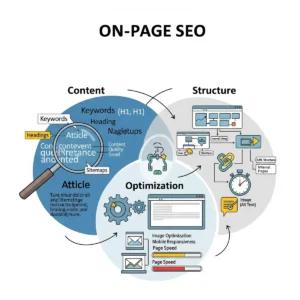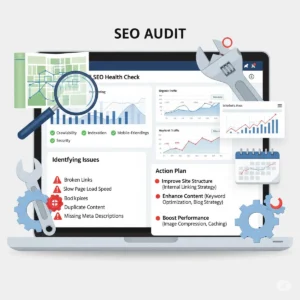What Is Organic Keyword Research & Why Is It Important?
From my experience in SEO, organic keyword research is essentially the process of analyzing data to understand what users are constantly searching for. By identifying the queries, phrases, and key words people use when they are looking for information, you can enhance your content and site to naturally rank higher in Search Engine Optimization (SEO) results.
Unlike paid campaigns, which involve paying a cent for visibility, organic keyword strategy focuses on giving people the information they want, boosting your blog or website’s authority without direct cost. Determining the right keywords is important because it aligns your strategy with what people are truly searching, allowing you to focus on words that find your site naturally, making your job easier while constantly adapting to evolving search behavior.
Benefits Of Organic Keyword Research
Increase Organic Traffic
- Conducting organic keyword research helps your site rank higher in Search Engine Results Pages (SERPs).
- Higher rankings drive more organic traffic from users actively searching for relevant content.
Increase Conversion Rate
- Targeted keywords align with your users’ needs, making it easier for them to find what they’re looking for.
- When users find relevant content, they are more likely to take action, such as purchasing a product or service.
Stay Up-To-Date With User Behavior
- Regular keyword analysis helps you track shifts in your audience’s search behavior.
- Insights from trending keywords allow you to adapt marketing strategies to current interests and needs.

Setting the Stage: Preparation & Goals
Before diving headfirst into keyword research, setting the stage with proper preparation and clear goals is crucial. Taking time to lay the groundwork ensures your efforts are focused and effective.
- Understanding your audience is the first step to defining relevant keywords.
- Defining goals helps align your research with the results you want to achieve.
- Equipping yourself with the right tools allows you to analyze data and track performance in detail.
- Take a moment to look at each aspect of your strategy before proceeding to ensure nothing is overlooked.
1. Define Your Target Audience
Understanding your target audience is fundamental for effective keyword research. Knowing who you want to reach on your website shapes the way you create content.
- Analyze demographics, interests, and pain points to identify common questions and problems your site can solve.
- Creating detailed buyer personas helps visualize your ideal customer and understand their needs.
- The right keywords will reveal customers’ search habits and show what answers they are actively looking for.
2. Outline Your Business Objectives & SEO Goals
Before diving into keywords, outline your business objectives and SEO goals to guide your efforts.
- Define what you hope to achieve with your website, such as increasing brand awareness, driving sales, or generating leads.
- Defining clear, specific, and measurable goals is essential to shape your keyword strategy.
- Ensure goals are aligned with overall business objectives, realistic, achievable, and consider industry competition and available resources.
3. Choose Your Keyword Research Tools
Choosing the right keyword research tools is key to equipping yourself for success. The difference between tools can be wide, with both free options like Google Trends and powerful paid platforms such as LowFruits or Semrush.
- Match tools to your budget, technical expertise, and specific needs. Small businesses often benefit from long-tail keywords that translate to easier ranking opportunities and higher conversion rates.
- Advanced SEO and digital marketers may prefer tools with comprehensive backlink analysis, robust features, and unique data.
- Explore options and recommendations to find the picks that best suit your business.
Your Keyword Research Checklist: Step-by-Step
A solid keyword research checklist acts as a step-by-step guide to ensure you set the stage before you dive into the process. Taking the time to follow each step helps you uncover valuable keywords and build a strong foundation for your content strategy.
1. Brainstorm Seed Keywords
Start with the basics by brainstorming seed keywords to lay the foundation of your research. Use broad terms that are relevant to your business, products, or services.
- Identify core topics your website covers and the main problems you solve for your audience.
- Consider your online store, such as selling organic coffee beans, fair trade, or specialty products.
- Avoid overthinking—jot down relevant, obvious ideas as a starting point for expanding and discovering more specific keywords.
2. Expand Your Keyword List
Next, broaden your horizons by using keyword research tools to expand your keyword list.
- Tools like LowFruits or Google Autocomplete help uncover a wider range of related terms.
- View reports manually or automatically to analyze high-intent users likely to convert.
- Track data, metrics, and credits to acquire targeted keywords for direct search queries.
3. Evaluate Keyword Difficulty
Evaluate keyword difficulty to prioritize efforts and focus on what’s easier to rank.
- Assess competition, search volume, domain authority, and backlinks.
- Use tools to get a score for each keyword, balancing high-quality content and relevant audience targeting.
- Focus on lower-competition keywords suitable for small business owners to achieve success in SERPs.
4. Find Long-Tail Keywords
Long-tail keywords are longer, more specific phrases people search for, often with lower volume than short-tail keywords.
- They improve conversion rates by targeting audience with clear intent, e.g., “best organic coffee beans espresso machines.”
- Helps attract qualified traffic, drive conversions, and rank easier in competitive results.
- Filter keywords with a minimum word count of 3 for more precise targeting.

5. Extract Competitors’ Keywords
Extract competitors’ keywords to gain insights and opportunities in your SEO strategy.
- Analyze top-ranking domains using tools to download reports and see positions in a spreadsheet or Excel.
- Review URLs, rankings, and website features to identify new opportunities.
- Use this step to enhance your own keyword selection and stage your content effectively.
6. Perform a Content Gap Analysis
Content gap analysis helps identify topics and keywords competitors cover that your site might miss.
- Compare your list of ranking pages with competitors to reveal gaps.
- Create new content such as blog posts, videos, or infographics to fill gaps and attract a wider audience.
- Discover valuable keywords like “cold brew coffee” to outrank competitors on important web pages.
7. Determine Search Intent
Determining search intent is crucial to create content that resonates with your audience.
- Understand why users search—informational, navigational, commercial, or transactional queries.
- Example: “brew coffee at home” (informational) vs. “buy espresso machine” (transactional).
- Use tools like Keyword Magic Tool and SERP analysis to learn what’s relevant and compete effectively.

8. Build Topic Clusters
Build topic clusters by grouping related keywords to improve website SEO and user experience.
- Organize content around a central pillar with subtopic pages, internal links, and interconnected structure.
- Focus on topical authority in your niche, e.g., coffee brewing methods, types, and origins.
- Ensure clusters support long-form content, guides, and dedicated landing pages for a comprehensive strategy.
9. Create Your Content Strategy
Finally, create your content strategy by organizing identified keywords and topic clusters.
- Align content with search intent, ensuring it is high-quality, engaging, and valuable.
- Optimize for SEO naturally, avoiding keyword stuffing.
- Promote via social media, email marketing, and other channels to attract a wider audience.
- Ensure the strategy aligns with business goals, resonates with users, and drives results.
Bonus: Implement Your Keyword Research
The crucial step after creating a content strategy is to implement your keyword research. This is where strategy turns into action, allowing you to optimize your website for search engines strategically.
- Incorporate target keywords in key areas like title tags, meta descriptions, headers (H1, H2, H3), and URLs to impact rankings and organic clickthrough rates.
- Use compelling, clear language to entice users while keeping on-page SEO factors in mind. Keep meta descriptions brief but informative, summarizing what the web page appears to offer.
- Structure your content body for readability, highlighting important topics, and naturally incorporating keywords without stuffing, while providing high-quality, informative content that satisfies user intent.
- Sprinkle LSI keywords, use image alt text, and maintain proper accessibility to enhance user experience.
- Tools like SEOBoost, WordPress integrations, All in One SEO (AIOSEO), and Writing Assistant provide real-time feedback, on-page optimizations, and color-coded systems to visualize keyphrases and suggest improvements.
- Regularly use this handy checklist to streamline optimization, generate new ideas, and ensure content is valuable, engaging, and aligned with user intent.

Next Steps: Track Your Keyword Performance
Tracking keyword performance is an ongoing process that ensures your research and efforts continue to deliver results. Regular monitoring and refinement helps you understand what’s working and what’s not, allowing you to focus your efforts effectively.
- Use tools like LowFruits or Rank Tracker to monitor keyword data automatically, including positions, historical changes, and overall progress.
- Set frequency for tracking, add country-specific selections, and fetch information relevant to your target audience.
- Choose user-friendly dashboards that are simple, accurate, and save valuable time compared to manual tracking.
- Leverage tracked data to expand selections, analyze changes, and adjust strategies to achieve your goals efficiently.
Final Thoughts
The comprehensive SEO keyword research checklist for 2025 is designed to guide you through a step-by-step process to uncover valuable keywords and create targeted content.
- Following these steps and utilizing the right tools helps you achieve sustainable growth.
- Remember, keyword research is an ongoing process—stay informed about the latest trends and algorithm updates.
- Consistent monitoring ensures your strategy remains effective so you can go forth and conquer the search landscape.
FAQs About Keyword Research
1. What are the 4 types of keywords?
- Short-tail keywords: Broad and general terms.
- Long-tail keywords: Longer, specific phrases with lower search volume but higher intent.
- Branded keywords: Include your brand name or product.
- Non-branded keywords: Generic terms not tied to any brand.
2. How to perform keyword research step by step?
- Brainstorm seed keywords relevant to your business.
- Expand your keyword list using tools like Google Trends or LowFruits.
- Evaluate keyword difficulty to prioritize efforts.
- Find long-tail keywords for higher conversions.
- Analyze competitors’ keywords for opportunities.
- Determine search intent and build topic clusters.
- Create and implement your content strategy.
- Track keyword performance regularly.
3. How many keywords per 1000 words?
- Aim for 5–10 primary and secondary keywords, naturally incorporated throughout the content without stuffing.
4. What is the SEO checklist?
- A step-by-step guide covering keyword research, on-page optimization, technical SEO, content strategy, and performance tracking.
5. What are four types of SEO?
- On-page SEO: Optimizing content and HTML elements.
- Off-page SEO: Backlinks and external signals.
- Technical SEO: Site speed, structure, indexing, and crawlability.
- Local SEO: Optimizing for local search results and maps.
6. What are the 4 C’s of SEO?
- Content: High-quality, valuable information.
- Code: Clean, optimized HTML and site structure.
- Credibility: Authority and backlinks.
- Context: Relevance to search intent and audience needs.










